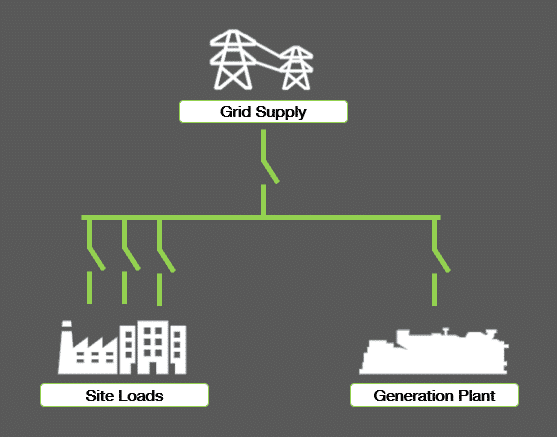The choice to deploy a combined heat and power (CHP) system, utilising reciprocating gas engines, is often an investment decision to help drive cost and carbon savings to an organisation, whose focus is not traditionally, power generation.
Clarke Energy have deployed CHP in numerous ‘critical’ applications around the world; whereby a power outage could cause considerable disruption to a client’s services. This could be in the form of power supply to a hospital, a production line within a factory or a data centre. In each scenario, if a complete power outage occurred, this would have significant repercussions.
Occasionally there is a misconception that the CHP plant replaces the grid. Whilst, the intention is often to offset as much of the grid supplied electricity as possible, the overall scheme is typically supplementary to the existing electricity infrastructure; as illustrated in the example single line diagram below. In countries where the grid is unreliable it is possible however to operate in full island mode operation.

A concern that customers may raise is, what happens if the CHP shuts down unexpectedly and what is the impact to the electricity supply?
The answer is simply – it should have no impact at all.
The system is designed in such a way, that should the CHP system shut down due to a fault, there will be a seamless transition to existing supplies, both electrically (through the grid or back-up diesels for example), and thermally (through retained boiler plant or chillers for example).
Compliance with the requirements of the ‘G99’ grid codes, ensures that power quality (voltage and frequency response times), remain within acceptable levels.
The CHP system will have been installed on the proviso that it provides savings; savings which will only be realised during continuous operation; therefore, having confidence that the equipment will be operational is just as important as having confidence that supplies are retained in the event of an outage. As such, Clarke Energy have invested heavily in our service support teams; which, when coupled with a comprehensive maintenance agreement, offering a minimum availability of 8,000 operating hours per annum (91.32% of the year), provides surety that the unit will run.
A large team of experienced field-based service engineers work with remote access to the operational fleet to optimise and prioritise responses; and are supported by workshop teams, an overhaul team, cylinder head line and spare parts specialists; with a dedicated behind-the-scenes service support facility – all working together to ensure maximum availability and reliability of the fleet, including through-the-life of your asset.




